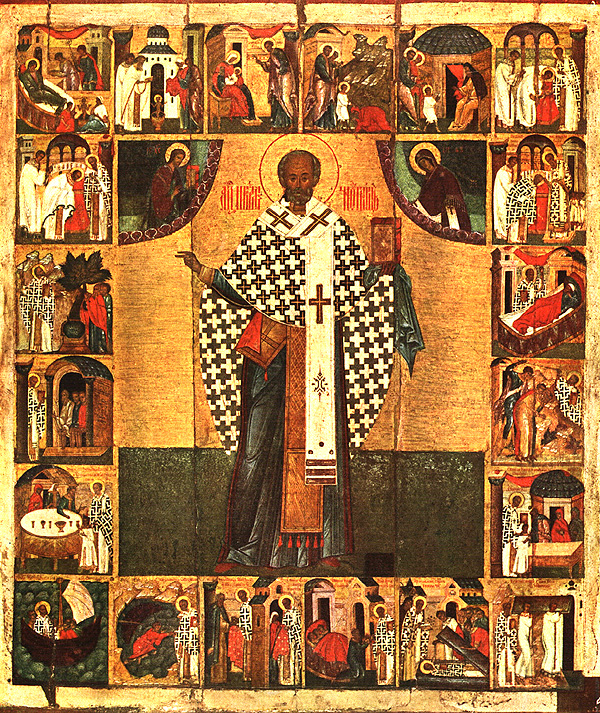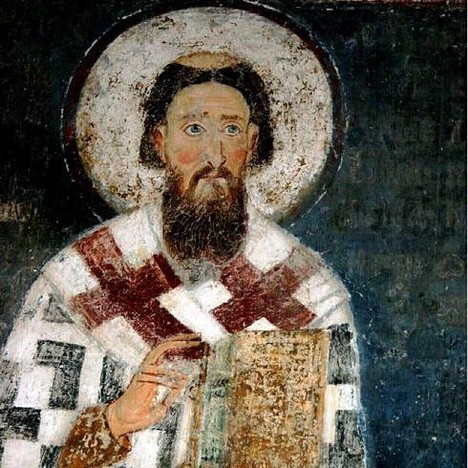Calendar
Holy Great-Martyr Prince Lazarus of Serbia
27. June 2015 - 21:18 Lazar was one of the Serbian noblemen who ruled the Serbian Empire after the death of Tsar Dushan. After the death of Tsar Urosh, Patriarch Ephrem crowned Lazar as the Serbian king. Lazar sent a delegation to Constantinople with the monk Isaiah to implore the patriarch to remove the anathema from the Serbian people. He fought against the Turkish powers on several occasions. Finally, he fought on the Field of Blackbirds (Kosovo Polje) on June 15, 1389 A.D. against the Turkish Emperor Murad I where he was beheaded. His body was translated and interred in Ravanica, his memorial church near Cuprija and later was translated to Ravanica in Srem and from there, during the Second World War (1942) was translated to Belgrade and placed in the Cathedral Church of the Holy Archangel Michael where it rests today incorrupt and extends comfort and healing to all those who turn to him with prayer.
Lazar was one of the Serbian noblemen who ruled the Serbian Empire after the death of Tsar Dushan. After the death of Tsar Urosh, Patriarch Ephrem crowned Lazar as the Serbian king. Lazar sent a delegation to Constantinople with the monk Isaiah to implore the patriarch to remove the anathema from the Serbian people. He fought against the Turkish powers on several occasions. Finally, he fought on the Field of Blackbirds (Kosovo Polje) on June 15, 1389 A.D. against the Turkish Emperor Murad I where he was beheaded. His body was translated and interred in Ravanica, his memorial church near Cuprija and later was translated to Ravanica in Srem and from there, during the Second World War (1942) was translated to Belgrade and placed in the Cathedral Church of the Holy Archangel Michael where it rests today incorrupt and extends comfort and healing to all those who turn to him with prayer.
Holy Apostles Bartholomew and Barnabas
24. June 2015 - 11:01 Saint Bartholomew, the Apostle. Bartholomew was one of the Twelve Great Apostles. In all probability, it appears that Bartholomew and Nathaniel are one and the same person. He was a companion of the Apostle Philip and Philip's sister, the virgin Mariamna and, for some time, a companion of St. John the Theologian. Bartholomew preached the Gospel first throughout Asia and, after that, in India and finally in Armenia where he died a martyr's death. In Hierapolis, these holy apostles by prayer, caused the death of a large serpent which the heathens kept in their temple and worshipped. In this same city and, by prayer, they restored sight to Stachius who was blind for forty years. It was here that a mob rose up against them and they crucified Philip and Bartholomew (Bartholomew was crucified upside down). At this time, an earthquake occurred in which the evil judges and may people perished. Feeling that this was a punishment from God, many ran to remove the apostles from the crosses but Philip was already dead while Bartholomew was still alive. After this, Bartholomew went to India where he preached and translated the Gospel of St. Matthew into the Indian language.
Saint Bartholomew, the Apostle. Bartholomew was one of the Twelve Great Apostles. In all probability, it appears that Bartholomew and Nathaniel are one and the same person. He was a companion of the Apostle Philip and Philip's sister, the virgin Mariamna and, for some time, a companion of St. John the Theologian. Bartholomew preached the Gospel first throughout Asia and, after that, in India and finally in Armenia where he died a martyr's death. In Hierapolis, these holy apostles by prayer, caused the death of a large serpent which the heathens kept in their temple and worshipped. In this same city and, by prayer, they restored sight to Stachius who was blind for forty years. It was here that a mob rose up against them and they crucified Philip and Bartholomew (Bartholomew was crucified upside down). At this time, an earthquake occurred in which the evil judges and may people perished. Feeling that this was a punishment from God, many ran to remove the apostles from the crosses but Philip was already dead while Bartholomew was still alive. After this, Bartholomew went to India where he preached and translated the Gospel of St. Matthew into the Indian language.
On the Sunday of All Saints of America
17. June 2015 - 13:26 In the name of the Father, and of the Son, and of the Holy Spirit. Amen
In the name of the Father, and of the Son, and of the Holy Spirit. Amen
Last week the Church celebrated the great feast of All Saints—in which every Saint, known and unknown is commemorated—and this Sunday we commemorate specifically all the Saints of Russia, while especially in America is celebrated the Feast of All Saints of North America. We have been blessed with several great Saints in our land—St. Herman who first brought Holy Orthodoxy to this continent from Russia in the 1700's, St. Tikhon, the Patriarch of Moscow who founded our St. Tikhon's Monastery, St. Nikolai Velimirovich, who taught and reposed at our Seminary, and St. John Maximovitch, the wonderworking bishop of San Francisco, among several others. But there is one person in particular that I would like to talk about today—the monk and priest Fr. Seraphim Rose.
Pentecost: The Descent of the Holy Spirit
31. May 2015 - 12:27 In the Old Testament, Pentecost was the feast that occurred fifty days after Passover. As the Passover feast celebrated the exodus of the Israelites from the slavery of Egypt, so Pentecost celebrated God's gift of the ten commandments to Moses on Mount Sinai.
In the Old Testament, Pentecost was the feast that occurred fifty days after Passover. As the Passover feast celebrated the exodus of the Israelites from the slavery of Egypt, so Pentecost celebrated God's gift of the ten commandments to Moses on Mount Sinai.
In the new covenant of the Messiah, the Passover event takes on its new meaning as the celebration of Christ's death and resurrection, the "exodus" of men from this sinful world to the Kingdom of God. And in the New Testament as well, the Pentecostal feast is fulfilled and made new by the coming of the "new law," the descent of the Holy Spirit upon the disciples of Christ.
When the day of Pentecost had come, they were all together in one place. And suddenly a sound came from heaven like the rush of a mighty wind, and it filled all the house where they were sitting. And there appeared to them tongues as of fire, distributed as resting upon each one of them. And they were all filled with the Holy Spirit ... (Acts 2:1–4).
Translation of the relics of St Nicholas the Wonderworker from Myra to Bari
21. May 2015 - 23:08 St Nicholas the Wonderworker, Archbishop of Myra in Lycia. The Transfer of the Relics from Myra of Lycia to Bari in Italy His Life is found under December 6.
St Nicholas the Wonderworker, Archbishop of Myra in Lycia. The Transfer of the Relics from Myra of Lycia to Bari in Italy His Life is found under December 6.
In the eleventh century the Byzantine Empire was going through some terrible times. The Turks put an end to its influence in Asia Minor, they destroyed cities and villages, they murdered the inhabitants, and they accompanied their cruel outrage with the desecration of churches, holy relics, icons and books. The Mussulmen also attempted to destroy the relics of St Nicholas, deeply venerated by the whole Christian world.
The Burning of Relics of Saint Sava
10. May 2015 - 12:49 Sava was the Archbishop of the Serbs. The body of St. Sava was buried in Mileshevo Monastery. During the time of the Turkish tyranny, the Serbian people gathered around the relics of their saint to seek comfort and healing. Fearing that an insurrection might arise from that place against the Turks, Sinan Pasha of Belgrade ordered that the relics of St. Sava be translated to Belgrade and there to be burned on Vracar, April 27, 1594 A.D. With the burning of the relics of this saint, the rabid Pasha did not burn the saint who remained alive before the Throne of God in the heavens and in the hearts of his people on earth.
Sava was the Archbishop of the Serbs. The body of St. Sava was buried in Mileshevo Monastery. During the time of the Turkish tyranny, the Serbian people gathered around the relics of their saint to seek comfort and healing. Fearing that an insurrection might arise from that place against the Turks, Sinan Pasha of Belgrade ordered that the relics of St. Sava be translated to Belgrade and there to be burned on Vracar, April 27, 1594 A.D. With the burning of the relics of this saint, the rabid Pasha did not burn the saint who remained alive before the Throne of God in the heavens and in the hearts of his people on earth.
Source: Prologue of Ochrid

